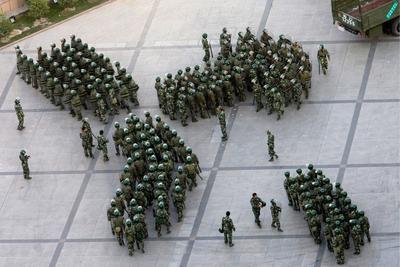And, more crucially, it is not clear that China has thought about how it could use the significant economic leverage it wields in the region to ensure stability. This is unfortunate because Afghanistan presents China with the opportunity to show the world it is a responsible global leader.
Despite having looked askance at NATO’s ill-advised efforts, the presence of NATO forces in Afghanistan has provided China with a sense of stability. NATO’s presence in Afghanistan has kept regional terrorist networks focused on attacking Alliance forces rather than stirring up trouble in neighbouring countries like China. NATO’s targeting of Islamist groups has also affected anti-Chinese Uyghur groups seeking refuge in Afghanistan under the protection of the Taliban or al-Qaeda.
Yet, as the date of the withdrawal approaches, this security dynamic is changing. While China does worry about the threat of Islamist Uyghur groups based in Afghanistan, its bigger concern is that a return to chaos in Afghanistan could undermine the rising number of Chinese investments in the country and the surrounding region. These investments are part of a broader push into Central Asia stemming from China’s efforts to transform Xinjiang, a historically underdeveloped province on the border with Afghanistan, into a ‘gateway to Eurasia’. China would also suffer if instability in Afghanistan expanded northward into Central Asia or southward into Pakistan.
The solution to this problem is complex. China should focus on what it can do best: continue to invest in Afghanistan and develop its abundant natural resources. Large investment projects could help rebuild parts of Afghanistan and transform the economy from one that is reliant on the drug trade and foreign aid into one that is self-reliant.
Investments made by Chinese state-owned firms have so far met with mixed success. In particular, the Mes Aynak mine in the country’s south, operated by the Metallurgical Corporation of China (MCC) and Jiangxi Copper, has been plagued with problems and uncertainty. In part this is because companies operating in the south face understandable security concerns, ranging from angry locals who feel they have not received just compensation for affected land, to strikes from Taliban-affiliated groups eager to punish the central government by undermining efforts to develop the country.
But Chinese companies can also lack a full understanding of the local environment. Communication with local governments can be problematic, particularly when projects fail to deliver elements that were supposedly included in the original contract. The local Afghan government initially believed that MCC and Jiangxi Copper would build a train line in the south. But both companies claim the contract only stipulated it would conduct a feasibility study. They also claim that the security situation has driven Chinese workers to refuse to work onsite, though it is unclear whether these stoppages have actually occurred.
By contrast, Chinese energy giant CNPC was able to bring online the oil field in Amu Darya in northern Afghanistan relatively quickly. The company has said that it is going to develop a refinery in Afghanistan to help facilitate Afghan energy independence. Still, political complications created by local Afghan strongman Rashid Dostum have held up work, and it is unclear whether these problems have been completely resolved.
These two projects show the potential benefits and downsides to investing in Afghanistan. But Chinese investment alone cannot transform Afghanistan into a stable and prosperous state. China also needs to leverage its power within the region and persuade other countries to engage in Afghanistan. The Shanghai Cooperation Organisation (SCO), a regional entity led by China, has done very little in Afghanistan due to a lack of agreement among members. China believes the SCO should do more, but other member countries prefer a bilateral approach. This is unfortunate because the SCO could enable China and other regional actors to cooperate to counter the regional narcotics trade and strengthen border controls.
Another option is for China to use its growing influence in the Asian Development Bank, which has already invested heavily in Afghanistan, to help connect Afghanistan to the broader region and reintegrate the nation into the global community. This approach complements China’s broader strategy of turning Xinjiang into the ‘gateway for Eurasia’. China should also foster person-to-person contact with Afghanistan by trying to entice more Afghans to study and work in China through scholarships and study grants.
China has an opportunity in the next year to assert some leadership to help steer Afghanistan in a more positive direction. A stable Afghanistan is in China’s national interest, and taking the lead on this issue could help bolster Beijing’s global position. Making up for the West’s previous mistakes will undoubtedly take time. But investing in a stable Afghanistan now will save years of trouble later.
Raffaello Pantucci is a Senior Research Fellow at the Royal United Services Institute and the co-editor of China in Central Asia.
A version of this article was first published here by the Carnegie Endowment for International Peace.

